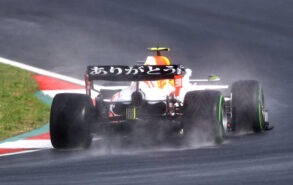G-force

Sergio Perez of Mexico driving the (11) Red Bull Racing RB16B Honda during final practice ahead of the F1 Grand Prix of Turkey at Intercity Istanbul Park
G-force is a measure of the acceleration that a driver experiences while racing in a Formula 1 car. It is measured in units of "g," with 1 g being equivalent to the acceleration due to Earth's gravity. In Formula 1 racing, drivers can experience G-forces up to 6g, which is six times the force of gravity.
G-forces are experienced by the driver in different situations, such as when braking, accelerating, and cornering. When braking, the driver experiences negative G-forces, also known as deceleration. This is the force that pushes the driver forward in their seat as the car slows down. On the other hand, when accelerating, the driver experiences positive G-forces, which pushes the driver back in their seat. Cornering also generates high G-forces, as the car is moving at high speeds while turning, this force can make the driver feel as if they are being pulled to the side.
The high G-forces experienced by Formula 1 drivers can put a lot of stress on the body. Drivers must be in excellent physical condition to handle the high G-forces, as it can put a lot of pressure on the heart and blood vessels. Additionally, the G-forces can cause disorientation, fatigue, and vision problems. Drivers must be able to handle this physical stress to be able to race at high speeds and make quick decisions on the track.
In summary, G-force is a measure of the acceleration that a driver experiences while racing in a Formula 1 car. It is measured in units of "g," with 1 g being equivalent to the acceleration due to Earth's gravity. In Formula 1 racing, drivers can experience G-forces up to 6g, which is six times the force of gravity. G-forces are experienced by the driver in different situations, such as when braking, accelerating and cornering.











LAST 3 F1 Fan COMMENTS